How to Improve the Ranking of Your Business Mobile App
It’s no secret we’re living in a mobile world.
As marketers, we need to recognize that our current and prospective customers are active on their mobile devices. That’s why you need to learn how to optimize your web design for mobile users.
But some of you may have taken this one step further and built a mobile app. That’s great news, and you’re definitely headed in the right direction.
Mobile apps are increasing in popularity.
If you saw my top mobile trends dominating 2018, you’re aware of this.
In fact, over half of small businesses in the United States either have mobile apps or are planning to develop one. Further, 55% of these business owners say they are using mobile apps to drive sales.
Those of you who already developed an app have an advantage over your competition.
But your app won’t be successful unless you can get people to download it.
Ultimately, the more downloads you get, the greater the chance you’ll have of getting more sales and increasing your total revenue.
The ranking of your mobile app has a direct correlation with the number of downloads you’ll get. But getting lots of downloads will also improve the ranking of your app.
It’s a constant cycle. Basically, if you’re able to get downloads, the popularity of your app will increase.
As a result, the ranking will improve, and the downloads will continue.
While it may sound complicated at first, it’s not difficult to understand. I’ll explain what you need to do to drive downloads and improve the ranking of your mobile app.
Understand the basic concepts of app store optimization (ASO)
For starters, you need to understand ASO, which is short for app store optimization.
Having a mobile app without focusing on ASO is like having a website without focusing on SEO (search engine optimization). ASO is extremely important.
That’s because such a large percentage of app users discover new apps by browsing the app stores:
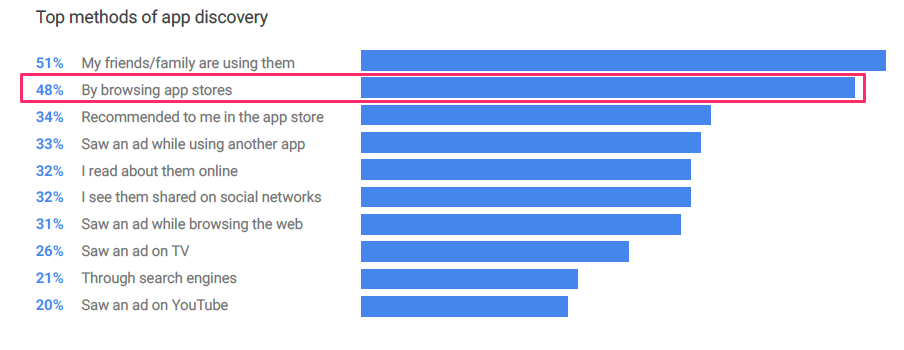
Think of the app store as a general search engine.
Someone knows what they want but doesn’t know where to find it. So they type some general terms into the search box.
Just like with a web browser, mobile users won’t go through dozens of results after they conduct a search. They’ll select one of the top results.
Those are the apps that will get the most number of downloads.
It’s the same concept as Google searches. The top ranking results will get the majority of the traffic.
You need to learn which factors can increase your chances of getting ranked higher according to ASO. We’ll cover some of these concepts as we continue.
Recognize the differences between the Apple App Store and Google Play Store
Let’s continue talking about the basics. There are two main app stores.
The Apple App Store is for iOS users, whereas the Google Play Store is for Android users.
Depending on your business, your app might be available on one or both of these platforms.
You need to know which factors impact your ranking in each store. The algorithms for ranking apps are not the same.
Here are some of the key similarities and differences between the Apple App Store and the Google Play Store:
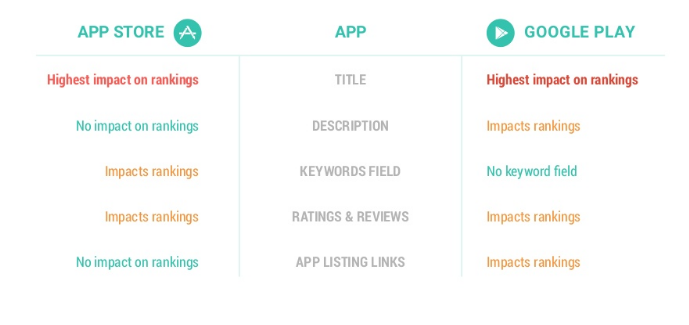
As you can see, the title of your app has the highest impact on your ranking in both stores. We’ll talk more about your title in greater detail shortly.
Similarly, the ratings and reviews of your app also affect the ranking of your app on each platform.
However, there are some major differences as well.
Your app’s description impacts rankings in the Google Play Store. But iOS users may not want to download your app unless you’re able to describe it, even though the description doesn’t directly impact your ASO. But we’ll discuss tips for writing app descriptions later on.
The keywords field in Apple App Store apps will impact your ranking, but that field isn’t even an option in the Google Play Store.
Ultimately, you’ve got to find the right approach to each of these two stores.
You can’t expect the same ASO strategy to work for each platform, so you’ll need to make the necessary changes in your listing in each store.
Make sure you have a great title
You need to put some thought into creating a title for your app. This may be easier for some of you than others.
For example, if you already have an established business and your app is just an extension of it, you’ll want the name to be the same for your branding purposes.
But those of you who are launching an app as a completely new business will benefit from reviewing my tips for naming your startup.
You want the title of your app to explain the function of your app and what it does.
Here’s an example of a great title from OfferUp:
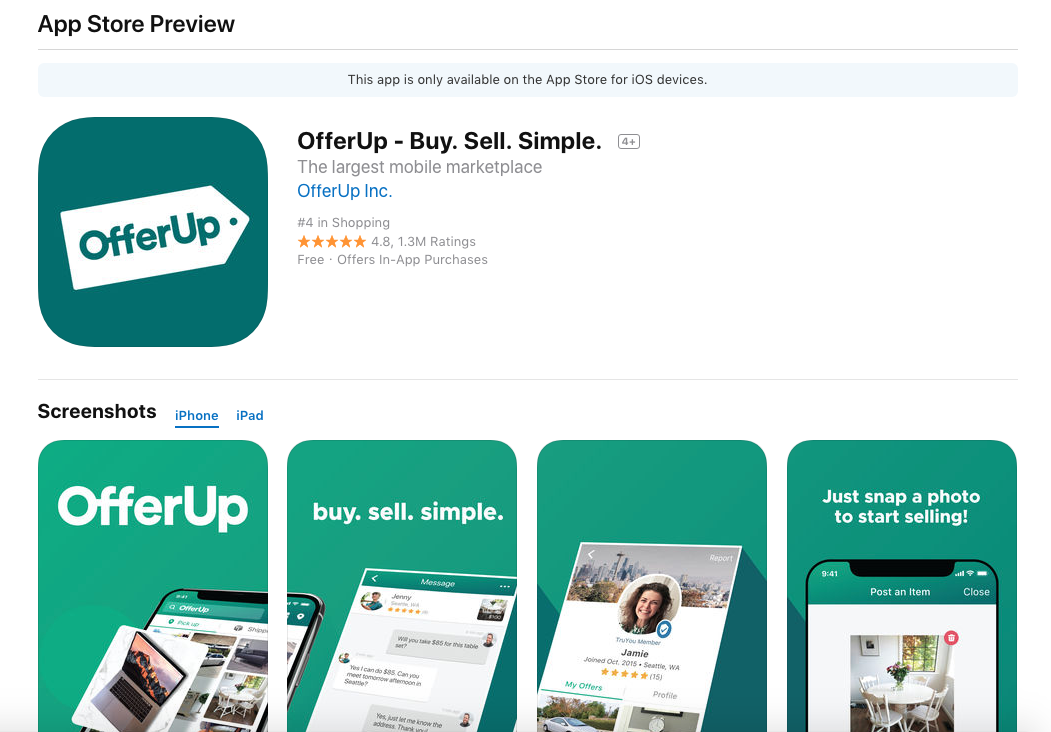
OfferUp is an app designed for buying and selling goods. As you can see, those keywords are also included in the title for ASO purposes.
However, it’s worth noting that the Google Play Store could potentially suspend your app if you’re using repetitive and irrelevant keywords in your title just to improve your ASO ranking.
Here’s something else to take into consideration. The Google Play Store gives you a 50-character limit to name your app.
But the Apple App Store has a 30-character limit for titles.
As far as the ASO algorithms are concerned, having different names on each platform won’t impact downloads.
However, from a branding perspective, you want your app name to be identical in each store. Here’s why.
Let’s say a user with an iOS device downloads your app from the Apple App Store. Then they recommend it to a friend who has an Android phone.
If the names are different, it can cause major confusion. That new user may not be able to find your app if they’re searching for the wrong title.
Write an informative description
As I explained earlier, your app description impacts your ranking in the Google Play Store.
This is a great opportunity for you to include relevant keywords that prospective users may search for when browsing for a new app.
Even though your description is irrelevant to your ASO ranking on the Apple App Store, you still need to write one that’s informative. Why?
Well, how else will people know what your app does? Sure, the title may give them some kind of indication, but the description is your chance to shine and explain your app’s functionality.
If you want to know how to write a great description, take a look at this example from Uber:
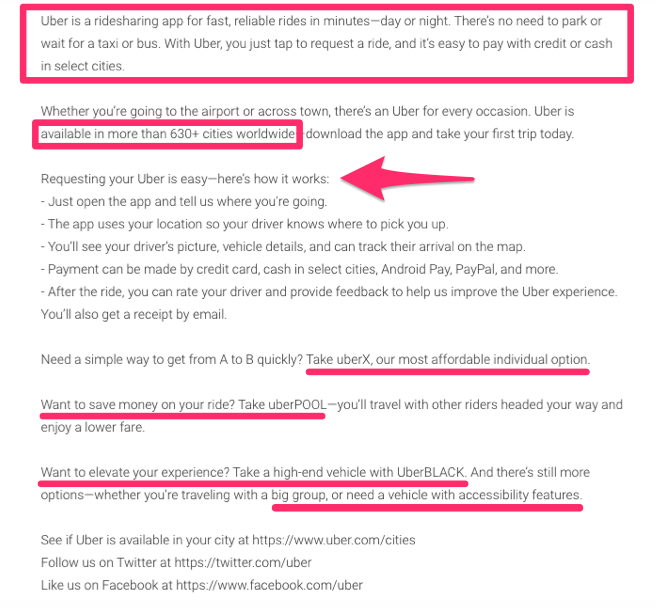
I pointed out some of my favorite parts.
For starters, the entire description isn’t displayed when a user first clicks on the app. That’s why the opening lines are the most important.
In the first three sentences of this description, Uber clearly explains what its app does.
As the description continues, it showcases the platform’s availability in cities across the globe. There is even a simple step-by-step guide to explain how the app works.
Another great part about this description is how it promotes all the services offered within the app.
Customers who want a simple and affordable way to get around will benefit from using uberX. If someone wants to save even more money, the description recommends uberPOOL.
The description explains that UberBLACK is intended for customers who want to ride in a high-end vehicle.
Uber also offers rides to app users who need accessibility features and to people traveling in big groups. All of this information was clearly written in the description.
Keep this in mind when you’re writing the description for your app. Make sure it’s simple while still highlighting the top features and how the app works.
Encourage users to rate and review your app
How your app is rated and reviewed will have an impact on your ranking in both app stores. It’s important you encourage users to review your app.
Your star rating impacts your ranking in a number of ways. First of all, the higher your rating, the greater your chances of getting ranked higher.
And having four or five stars increases the chances that consumers will download your app.
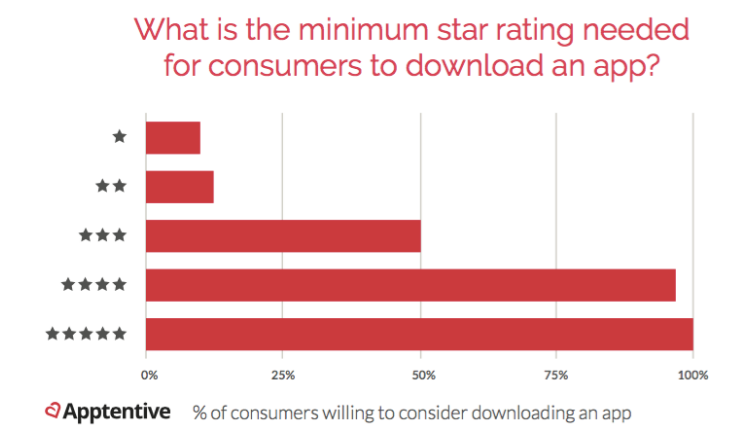
In fact, 79% of users check ratings and read reviews before they download a new app.
As you can see in the graphic above, if your app is rated too low, people won’t even consider downloading it.
This is why it’s important for you to encourage users to rate and review your app. For the most part, people won’t write a review unless they have a really good experience or something terrible happens.
But an average user has no reason to go out of their way to write a review.
That’s why you need to ask them. Otherwise, your app ratings will just be from people who experienced something extreme.
Send users a popup or push notification that gives them an incentive to rate your app and write a review. This will improve your ASO and make your app more appealing to new users.
Improving the star rating of your app will do more than just increase your ranking. It also has a direct correlation with your conversions.
Check out this example from Medium:

Its conversion rates went from 36% to 47% as the app star rating jumped from 3.9 to 4.3.
Improving the rating by a small margin increased the app’s conversions by more than 10%.
Use screenshots to showcase the in-app experience
Your title and description can do only so much.
It’s one thing to tell users what your app can do, but it’s another thing to actually show them. That’s why you need to include screenshots.
Screenshots give you a chance to show off your app’s versatility.
For example, you wouldn’t want to show four screenshots of one feature. It makes much more sense to showcase different features with each image.
Let’s say you have an app for your ecommerce store. Showing screenshots of just products isn’t utilizing the option to its full potential.
You’re better off showing screenshots of your navigation, search options, checkout procedure, and payment methods. This will give the prospective user a much better indication of how the app functions.
Now, your screenshots aren’t directly tied to ASO. However, they’ll help you drive more downloads, which will ultimately improve your ranking.
Here’s a great example of screenshots displayed on the Delta app listing:

As you can see, each screenshot shows something different.
The first image shows what the app looks like on the day of travel. It’s a digital boarding pass that can save you time at the airport.
Next is an image that displays the user’s profile. The Delta app also shows travel notifications in an organized feed. This can keep users informed if there is a gate change or flight delay.
Finally, the last screenshot shows how users can book a trip directly within the app.
Varying screenshots increase the chances of your app being downloaded.
Create a video to demonstrate your app
In addition to taking screenshots, you can also use videos to demonstrate how your app works.
Just take a look at these numbers that show how many of the top 50 apps in the Google Play Store and Apple App Store incorporate videos:

As you can see, the majority of the top grossing apps on both platforms use videos.
Users are three times more likely to download an app after watching a video about it, so this strategy will definitely help you drive downloads.
Design an eye-catching app icon
Don’t overlook the design of your app icon.
While this doesn’t necessarily affect ASO, it will still have an impact on downloads and the way your app is perceived.
The app icon needs to be attractive so that it stands apart from other apps when users are browsing.
It should be memorable and related to your overall branding strategy. Don’t make it too similar to another app, especially if it’s your competitor.
Think about how your app is going to look once it’s downloaded to various devices. It needs to be visible against as many backgrounds as possible.
Take a look at the Slack mobile app icon:
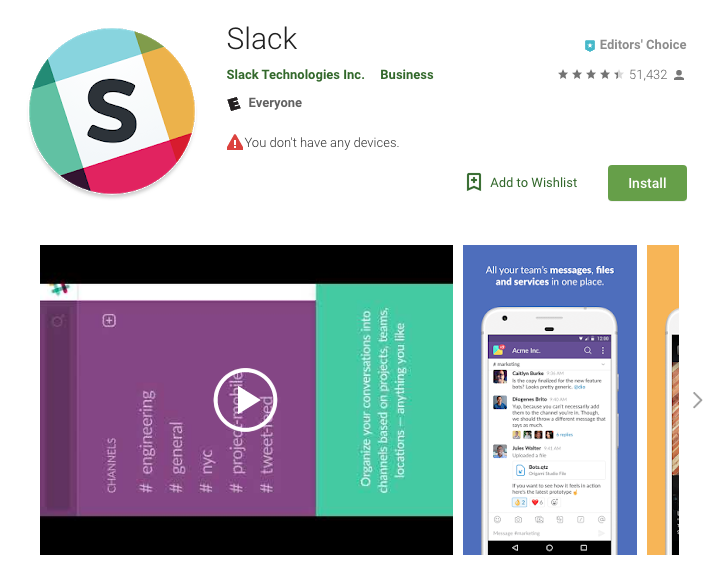
It’s colorful and draws attention. But it’s still simple.
Do you notice anything else about this app listing?
It has a video in addition to screenshots, which is a strategy I just finished discussing.
Promote the app on all your distribution channels
To get more downloads, ratings, and reviews, you need to promote your app.
Leverage all your distribution channels for this. Convert your social media followers into app users.
Create YouTube content that drives people to your app store listing. Market the app to your email subscribers.
Share download links to the app on your website. Here’s an example of this strategy put to use by Hotel Tonight:
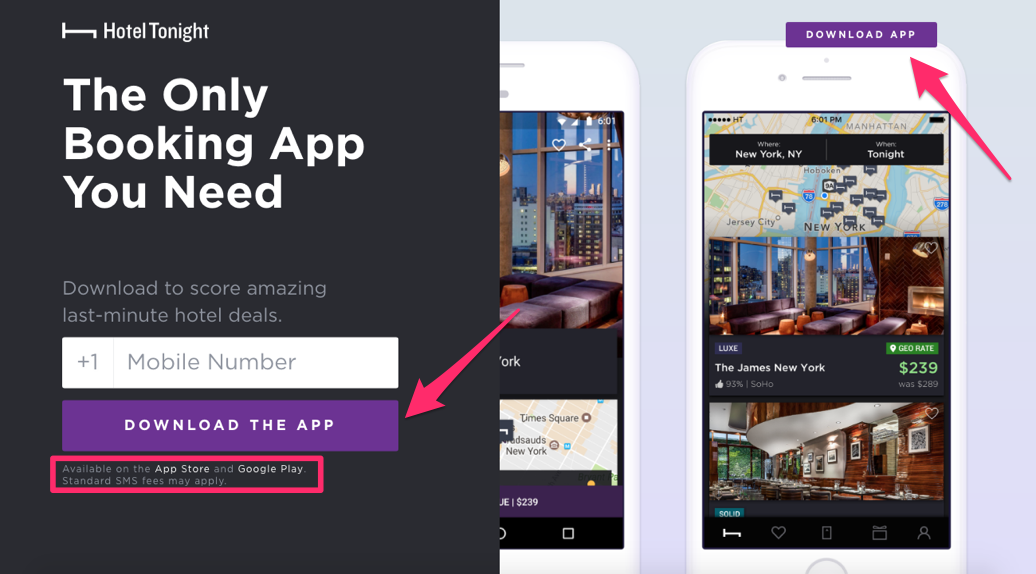
Even if you’re running your app as a new business without any physical stores or online purchase options, you still need to have a website as a promotional tool.
Conclusion
You invested hard work, time, and money into your mobile app.
But the job isn’t quite done yet. Now that your app has launched, you need to take the proper steps to improve its ranking. This will help you get more downloads.
Conduct research on ASO. Learn the differences between listing your app on the Google Play Store and the Apple App Store.
Focus on your title. Write an informative description.
Use screenshots to show the app’s functionality. Create a video demonstration.
Encourage users to rate and review your app.
Design an app icon that draws the attention of prospective users. Make sure to promote your app on as many distribution channels as possible.
If you follow the tips I’ve outlined in this guide, your app ranking will improve, and you’ll get more downloads. These downloads will ultimately translate into higher profits.
How are you using ASO principles to increase your mobile app ranking?
COntributer : Quick Sprout https://ift.tt/2MqCQmI
 Reviewed by mimisabreena
on
Thursday, August 16, 2018
Rating:
Reviewed by mimisabreena
on
Thursday, August 16, 2018
Rating:

















No comments:
Post a Comment